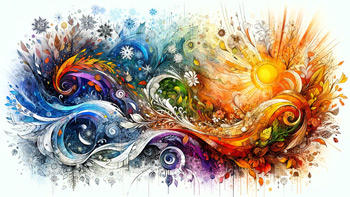Seasonal celebrations are a fascinating and integral part of human culture, deeply rooted in the history, traditions, and rhythms of nature. These celebrations, varying across different cultures and geographies, mark the changing of the seasons and are often tied to agricultural cycles, religious beliefs, and ancestral traditions. From the blossoming of flowers in spring to the harvests of autumn, each season brings its own set of festivals and rituals, reflecting the diversity and richness of cultural practices around the world.
Spring Festivals
Spring, symbolizing rebirth and renewal, is welcomed with a variety of celebrations. In Japan, the Cherry Blossom Festival, or 'Hanami,' is a time when people gather under blooming cherry trees to enjoy the transient beauty of the blossoms, reflecting on the fleeting nature of life. The festival of Holi in India, known as the 'Festival of Colors,' is another vibrant spring celebration. It's a jubilant day when people smear each other with colors and water, signifying the victory of good over evil and the arrival of a fruitful season.
Summer Celebrations
Summer festivals are often characterized by their vibrant energy and communal spirit. In many cultures, summer is celebrated as a time of abundance and social gatherings. The Midsummer festival in Sweden, for instance, is a time for families to come together, decorate their homes with greenery, and dance around the Maypole. Similarly, in the United States, the Fourth of July commemorates the country's independence with fireworks, parades, and barbecues, epitomizing the spirit of freedom and community.
Autumn Festivals
Autumn, a season celebrated for its vibrant colors and bountiful harvests, is marked by a variety of festivals around the world, each reflecting the unique cultural nuances and traditions of their regions. Beyond the well-known harvest celebrations, autumn is also a time for diverse festivals that encompass themes of change, preparation for the coming winter, and reflection on the year gone by. In the United States, Halloween is a standout event, characterized by costume-wearing, trick-or-treating, and pumpkin carving, originally stemming from ancient harvest festivals and rituals honoring the dead. In Mexico and other Latin American countries, Dia de los Muertos, or the Day of the Dead, is a poignant and colorful celebration that honors departed loved ones, blending indigenous rituals with Catholic traditions. In the UK, Bonfire Night or Guy Fawkes Night on November 5th commemorates the foiling of the Gunpowder Plot of 1605 with fireworks and bonfires. Germany’s Oktoberfest, although starting in late September, extends into autumn and is world-famous for its celebration of Bavarian culture, especially its beers. Meanwhile, in parts of Asia, festivals like Chuseok in Korea and Tsukimi in Japan celebrate the harvest moon and the ancestors, involving special food preparations and offerings. Each of these festivals, in their own way, highlight the essence of autumn: a period of transformation, celebration of life’s cycles, and community togetherness. They showcase the beauty of the season not just through their varied customs and traditions but also in how they bring people together, weaving a tapestry of shared human experiences across the globe.
Harvest Festivals
Harvest time brings a rich tapestry of festivals across the world, each celebrating the bounty of nature in its own unique way. In North America, Thanksgiving stands out as a time-honored tradition where families gather to share a meal, giving thanks for the year's harvest and blessings. Similarly, in East Asia, the Mid-Autumn Festival, or Moon Festival, is celebrated with mooncakes and lanterns, symbolizing gratitude for the harvest and the splendor of the moon. European countries like Germany and the United Kingdom mark this season with traditional harvest festivals, involving church gatherings, decorations of produce, and hymns of gratitude. In India, the vibrant festival of Navaratri, spanning nine nights, combines religious rituals with dances and music, reflecting themes of victory of good over evil. These harvest festivals are more than just a celebration of agricultural yield; they represent a time for communities to come together in thanksgiving and joy. They echo the deep connection humans have with the earth and the cycles of nature, emphasizing the importance of sharing, community bonding, and acknowledging the fruits of collective labor. The autumn season, draped in stunning hues of oranges, reds, and yellows, provides a picturesque setting for these culturally rich and diverse festivities, turning it into a period of reflection, celebration, and profound appreciation for nature’s generosity.
Winter Celebrations
Winter festivals often bring light and warmth to the colder, darker months. Christmas, celebrated globally, is marked by the decoration of Christmas trees, exchange of gifts, and family gatherings, symbolizing joy and goodwill. Hanukkah, the Jewish Festival of Lights, celebrates the miracle of the menorah oil in the temple and is observed by lighting candles over eight nights. In India, Diwali, the Festival of Lights, signifies the triumph of light over darkness with lamps, fireworks, and sweets.
Seasonal Celebrations and Community Bonding
One of the most beautiful aspects of seasonal celebrations is their ability to bring communities together. These festivals provide an opportunity for communal bonding, sharing, and understanding. They often involve collective activities like feasts, dances, and rituals, which strengthen community ties and reinforce social values.
Cultural and Historical Significance
Seasonal celebrations are not just mere festivities; they hold significant cultural and historical meanings. They are windows into the beliefs, customs, and histories of various cultures. Through these celebrations, we can trace the evolution of societies, understand their relationship with nature, and appreciate the diverse ways in which human cultures honor the cycles of the earth.
In essence, seasonal celebrations are a rich tapestry of human expression, woven through time and across cultures. They remind us of our connection to nature, our shared histories, and our communal spirit. These celebrations, in all their diversity, beauty, and tradition, are a testament to the enduring human spirit that finds joy, meaning, and a sense of belonging in the rhythm of the seasons.
